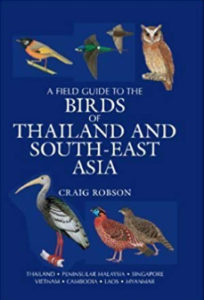Birds of Southeast Asia Field Guide
 Birds of Southeast Asia Field Guide
Birds of Southeast Asia Field Guide
We always prefer to recommend field guides that cover the specific country that we are birding in but sometimes this is impossible. This is where the Birds of Southeast Asia becomes our chosen publication for the region. Although this book has its limitations its main advantage is that it packs a lot of birds into a fairly lightweight book. The version pictured here is the most up-to-date one in taxonomic terms.
Birds of Southeast Asia is a field guide that can be useful for a few of our birding trips in the region:
- Thailand and Vietnam Pittas Birding Tour
- Peninsula Malaysia Birding Tour
- Central and Northern Thailand Birding Tour
- Myanmar Birding Tour; The Classic Route & Endemics
Using this field guide, that covers multiple destinations in Southeast Asia, may be more convenient than carrying more than one field guide for each of the countries visited on some of the above tours which visit more than one country. It is also useful for birding in countries in the region that do not have a field guide that is specific to those countries.
Range Maps
One of the limitations of any field guide that covers a whole region is the accuracy of range maps. However, the complete ommission of range maps for a region that is not as vast as many others is one of the main drawbacks of this publication. The plates themselves, nor the brief species accounts alongside them, carry any indication at all of the ranges of any of the birds included. Instead the species accounts at the back of the book describe the global range as well as slightly more specific details of where in Southeast Asia they occur. However, these descriptions are very confusing using geographical terms that most birders will not be familiar with such as Cochinchina, South Annam and East Tonkin. Range mapes would improve this field guide dramatically.
Illustrations
The illustrations are generally of a good standard with a high level of detail. However, the fact that a large number of artists produced them means that there is inconsistency in style and quality. The plates range from excellent, in the example of wagtails with illustrations of many subspecies, to below par in the case of Scimitar Babblers. While most of the illustrations themselves are good, many of the plates appear overcrowded, making them confusing to the eye. Obviously this decision was taken by the publishers to get a lot of information into a field guide that is of a manageable size. While the crowded plates can sometimes be annoying it is also true that if they were more spaced out this book would be far heavier than it is. The publishers have tried to create a balance.
As these paintings of birds were created in the days before digital photography, they were made from old photos and skins. This fact means that in many cases illustrations are not as vibrant in colour as they should be. This frequently results in a pleasant surprise in the field when a bird is far more visually impressive than in the book. It is possible to see some negatives as postives!
Species Accounts
The species accounts alongside the plates are very brief, in fact nothing more than a description of the bird. However, longer species accounts are provided in a seperate secrtion towards the back of the book. Although these accounts are what birders normally expect in a field guide with more detailed descriptions of male, female and juvenile plumages as well as information on habitat and range. Any important information on behaviour is also contained within this section. As previously mentioned, the range of each species is described, sometimes using unfamiliar geographic names, rather than detailed in a map. While the species accounts are generally quite useful, the fact that birders have to refer between the plates and these accounts at the back make it quite hard to use in the field.
Other Features
Inside the front cover there is a nice pictorial index of bird groups which allow birders to find the right page quickly and a well-ordered index at the back. This index has both common and scintific names within in it and is easy to use. The introduction to this book is brief with a short summary of the main habitat types within the region too. There is also an interesting section listing all the taxonoic updates since the version published in 2000 but, of course, many more changes have occurred since. A map of the region is available for reference on the inside of the rear cover of the book.
Recommended
We recommend this publication to participants on our tours to Southeast Asian countries where there is not already a designated field guide. It is also useful to birders accompanying us on tours that go in search of the birds of Southeast Asia in multiple countries in the region in order to cut down on the weight of their luggage. We would recommend the field guides that are specific to those nations as preference though.
